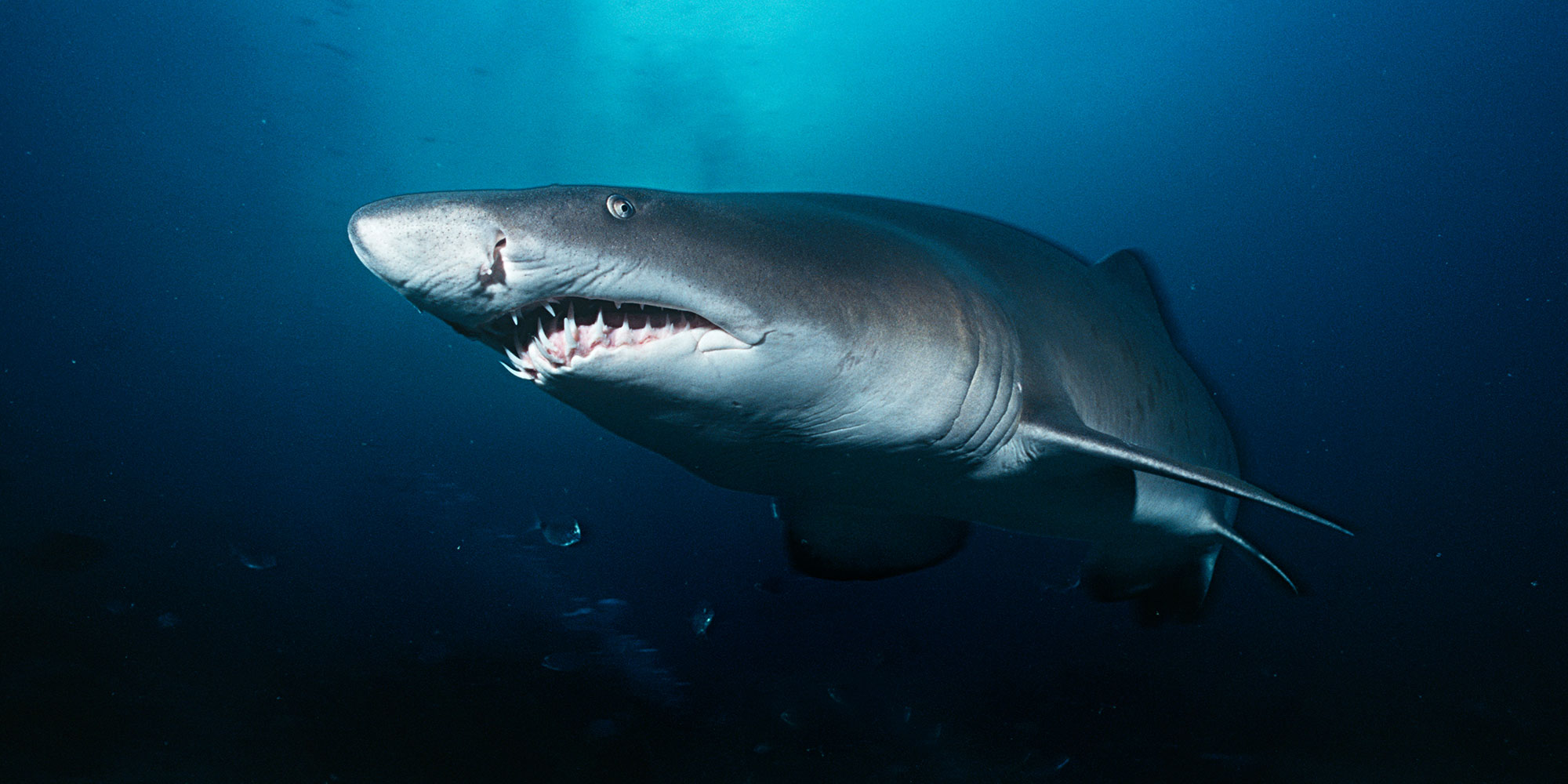Poseidon’s 12-foot trident, pillars, and other remnants of the Lost City of Atlantis Habitat create a ghostly environment for the inhabitants of the 120,000-gallon Lost City of Atlantis Shark Habitat.
Menacing-looking sand tiger sharks (Carcharias taurus), bottom-dwelling nurse sharks (Ginglymostoma cirratum), and a gaping moray eel (Gymnothorax funebris) join a massive Queensland grouper (Epinephelus lanceolatus) and other fish in an exhibit that forms the centerpiece of the Long Island Aquarium.
Sand Tiger Shark (Carcharias taurus), also known as the Raggedtooth Shark (in Africa), and Grey Nurse Shark (in Australia). Their range extends from the East Coast of the Untied States, including Long Island, down to South America, Africa to Japan and Australia. They aren’t typically located in the Pacific Coast.
The Sand Tiger shark is an endangered species due to overfishing and habitat loss. This species is protected in the US, Australia, and New Guinea. The Sand Tiger shark is not usually aggressive towards humans; however, will defend against aggression as well as try to nip at spearfishermen with bait or catch.
They range in length from 8 to 10 feet fully grown and can weigh up to 500 pounds, with the male sand tiger sharks typically bigger, although in our habitat our female sharks are larger than our male sharks.
Females reproduce ovoviviparously, meaning they develop eggs inside of the womb and hold on to them till they hatch. Typically, the two strongest to hatch first will consume the other eggs and then emerge from the mother. They are one of the lowest reproductive rate species of shark contributing to their dwindling numbers.
Long Island has been found to be a pupping ground for Sand Tiger sharks, females will have their pups in the waters surrounding Long Island. We know these animals spend time in our area in the summer. The adults will move into shallow, warmer waters at night to feed. In the winters, they move out to deeper, warmer waters further south.
Fun Fact:
Sand Tiger sharks can gulp air and hold it in their stomachs to assist with buoyancy.
Nurse Shark (Ginglymostoma cirratum) also knows as the Carpet Shark. They can be found from the East Coast of the United States, down to South America.
They range in length approximately 10-14 feet and can weigh from 165-230 pounds.
In a facility, they can live 20-25 years.
Nurse sharks are a nocturnal species and can be found on sandy bottoms inside of crevices or caves during the day, coming out to eat at night. They can typically be found in large groups, some with up to 40 individuals!
They are not aggressive towards humans and will chose to swim away when encountered. Aggression occurs mostly when they are chased around or accidently stepped on by on.
Nurse Sharks are ovoviviparous; they develop eggs inside the womb and hold on till they hatch. The females have large clutches of about 20-30 young.
Fun Fact:
In a facility, Nurse Sharks can often be seen interacting with divers cleaning their habitat.
Shocking Shark Facts
Senses
While sharks have senses similar to humans, they have some special senses, as well! For instance, sharks have tiny gel-filled sacs located along their snouts, known as the ampullae of Lorenzini. These structures allow them to sense minute electrical impulses, such as the heart beats or movement of their prey! Additionally, sharks have special pressure sensors running along the sides of their body, known as the lateral line. This faint line allows them to detect the movement of fish and other animals swimming around them.
Feeding
Our Sand Tiger Sharks are given five to seven pounds of food per week to keep them healthy and so they don’t bother their tank mates. Even though five to seven pounds of food may not sound like a lot, they are only estimated to eat about one pound of food in the wild per week! Since they are cold- blooded, or ectothermic, they don’t need to consume much energy! Incredibly, our Sea Lion, Java, eats the same amount of food in one day that our sharks eat in a month!
Teeth
Amazingly, Sand Tiger Sharks have seven rows of teeth in their mouth. They will lose about 1,000 teeth a year. Every few months our divers will pick up the teeth in this habitat. It will accumulate about 4,000 teeth a year and that is only from four Sand Tiger Sharks. Imagine how many shark teeth are on the bottom of the ocean!
Busting Shark Myths
MYTH: Sharks are man-eating predators.
FALSE! Of the roughly 480 species of sharks, fewer than six species are responsible for the majority of shark attacks. In fact, 75% of shark species rarely come in contact with humans! Regardless, sharks feed on marine invertebrates, fish, and marine mammals – not humans! When a shark attack does occur, it is likely a case of mistaken identity where the shark mistakes a human for one of its normal prey items like a seal or sea lion. So no, sharks do not hunt humans – it is 30 times more likely to be struck by lightning than to get attacked by a shark. Sadly, while there are about 2 human shark-related deaths per year, humans kill millions of sharks every year due to shark finning, overfishing and pollution. Who is the real threat here?
Despite their fearsome appearance, the sharks in the Lost City of Atlantis habitat, like most shark species, are not aggressive towards humans unless they are provoked. Learn this firsthand from within the shark tank! Make your reservations for a Shark Dive today and get a thrilling look at these beautiful animals from a sharks-eye view!
